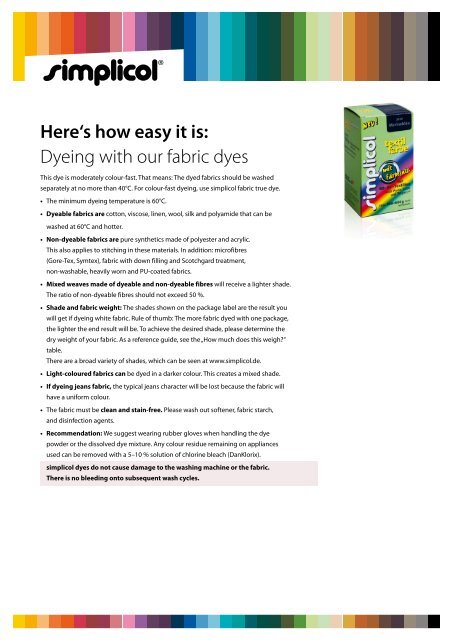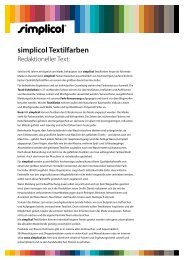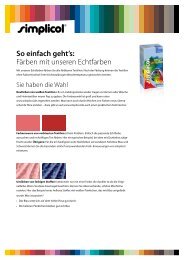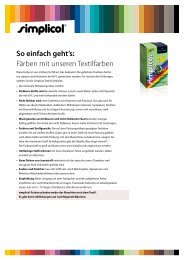Here's how easy it is: Dyeing with our fabric dyes - Simplicol
Here's how easy it is: Dyeing with our fabric dyes - Simplicol
Here's how easy it is: Dyeing with our fabric dyes - Simplicol
Create successful ePaper yourself
Turn your PDF publications into a flip-book with our unique Google optimized e-Paper software.
Here‘s <strong>how</strong> <strong>easy</strong> <strong>it</strong> <strong>is</strong>:<br />
<strong>Dyeing</strong> w<strong>it</strong>h <strong>our</strong> <strong>fabric</strong> <strong>dyes</strong><br />
Th<strong>is</strong> dye <strong>is</strong> moderately col<strong>our</strong>-fast. That means: The dyed <strong>fabric</strong>s should be washed<br />
separately at no more than 40°C. For col<strong>our</strong>-fast dyeing, use simplicol <strong>fabric</strong> true dye.<br />
• The minimum dyeing temperature <strong>is</strong> 60°C.<br />
• Dyeable <strong>fabric</strong>s are cotton, v<strong>is</strong>cose, linen, wool, silk and polyamide that can be<br />
washed at 60°C and hotter.<br />
• Non-dyeable <strong>fabric</strong>s are pure synthetics made of polyester and acrylic.<br />
Th<strong>is</strong> also applies to st<strong>it</strong>ching in these materials. In add<strong>it</strong>ion: microfibres<br />
(Gore-Tex, Symtex), <strong>fabric</strong> w<strong>it</strong>h down filling and Scotchgard treatment,<br />
non-washable, heavily worn and PU-coated <strong>fabric</strong>s.<br />
• Mixed weaves made of dyeable and non-dyeable fibres will receive a lighter shade.<br />
The ratio of non-dyeable fibres should not exceed 50 %.<br />
• Shade and <strong>fabric</strong> weight: The shades s<strong>how</strong>n on the package label are the result you<br />
will get if dyeing wh<strong>it</strong>e <strong>fabric</strong>. Rule of thumb: The more <strong>fabric</strong> dyed w<strong>it</strong>h one package,<br />
the lighter the end result will be. To achieve the desired shade, please determine the<br />
dry weight of y<strong>our</strong> <strong>fabric</strong>. As a reference guide, see the „How much does th<strong>is</strong> weigh?“<br />
table.<br />
There are a broad variety of shades, which can be seen at www.simplicol.de.<br />
• Light-col<strong>our</strong>ed <strong>fabric</strong>s can be dyed in a darker col<strong>our</strong>. Th<strong>is</strong> creates a mixed shade.<br />
• If dyeing jeans <strong>fabric</strong>, the typical jeans character will be lost because the <strong>fabric</strong> will<br />
have a uniform col<strong>our</strong>.<br />
• The <strong>fabric</strong> must be clean and stain-free. Please wash out softener, <strong>fabric</strong> starch,<br />
and d<strong>is</strong>infection agents.<br />
• Recommendation: We suggest wearing rubber gloves when handling the dye<br />
powder or the d<strong>is</strong>solved dye mixture. Any col<strong>our</strong> residue remaining on appliances<br />
used can be removed w<strong>it</strong>h a 5–10 % solution of chlorine bleach (DanKlorix).<br />
simplicol <strong>dyes</strong> do not cause damage to the washing machine or the <strong>fabric</strong>.<br />
There <strong>is</strong> no bleeding onto subsequent wash cycles.
Pflegeleicht<br />
Selecting the shade<br />
Once you know the weight of the <strong>fabric</strong>, you can select y<strong>our</strong> desired shade. W<strong>it</strong>h one<br />
package, you can create the following shades:<br />
• If the <strong>fabric</strong> weighs up to 300 g, you will receive a deep shade.<br />
• If the <strong>fabric</strong> weighs between 300 g and 600 g, a medium shade will be achieved.<br />
• 600 g or more achieve softer shades. If y<strong>our</strong> <strong>fabric</strong> weighs 600 g, and you w<strong>is</strong>h to<br />
have a deep shade, you will need two packages of simplicol.<br />
Please remember: The col<strong>our</strong> black can only be achieved if you follow the instructions for deep<br />
shades. The col<strong>our</strong> in the bottle and during the dyeing process may appear different than the<br />
shade on the label. The final shade <strong>is</strong> not v<strong>is</strong>ible until after subsequent washing and drying.<br />
Which dyeing method for which <strong>fabric</strong>s?<br />
W<strong>it</strong>h the exception of wool, and very delicate silk (see the „<strong>Dyeing</strong> wool and delicate silk in<br />
a pot“ section), all types of <strong>fabric</strong>s can be dyed in a washing machine, bowl or bucket.<br />
Polyamide and silks that can be washed in the washing machine may be treated at 60°C –<br />
even if manufacturer‘s instructions contradict.<br />
<strong>Dyeing</strong> in the washing machine<br />
• Maximum max °C <strong>fabric</strong> quant<strong>it</strong>y <strong>is</strong> 1.800 g (dry weight), for voluminous <strong>fabric</strong>s such as terry cloth<br />
and flannel 1.000 g (dry weight).<br />
• Place the clean, damp <strong>fabric</strong> in the machine drum. Articles of clothing should be turned<br />
inside out.<br />
• Cut open one or more dye packets at the upper edge and place them on the <strong>fabric</strong>.<br />
If dyeing silk, add an add<strong>it</strong>ional 750 ml vinegar (or approx. 150 ml vinegar essence (simplicol)<br />
into the drum.<br />
• Depending on the perm<strong>is</strong>sible <strong>fabric</strong> care temperature, select e<strong>it</strong>her 60°C or 95°C for<br />
the dyeing cycle (for silk and polyamide, 60°C). Then select the „delicate“ or „gentle“<br />
cycle – w<strong>it</strong>hout prewash, and w<strong>it</strong>h maximum water level (if possible) and start the machine.<br />
• Let the wash cycle run w<strong>it</strong>h all the rinse and spinning cycles.<br />
• When fin<strong>is</strong>hed, run a wash cycle w<strong>it</strong>h laundry detergent at 40°C. Remove the <strong>fabric</strong> and<br />
bag from the machine. Done! From now on, wash separately at a maximum of 40°C.
Pflegeleicht<br />
max °C<br />
<strong>Dyeing</strong> in a bowl or bucket<br />
<strong>Dyeing</strong> process description for 300 g <strong>fabric</strong><br />
• Please wear rubber gloves.<br />
• For the deep shade, d<strong>is</strong>solve the entire contents of one bag in 6 l<strong>it</strong>res of water (in plastic<br />
bowl max °C or bucket) heated to 60°C. In the case of silk only, add 300 ml vinegar or 50 ml vinegar<br />
essence (25 %).<br />
• Submerse the clean <strong>fabric</strong> thoroughly.<br />
• Allow to soak for approx. one h<strong>our</strong>, moving the <strong>fabric</strong> frequently.<br />
• When fin<strong>is</strong>hed, run a wash cycle at 40°C. From now on, wash separately at a maximum of<br />
40°C. If you w<strong>is</strong>h to dye 300 g <strong>fabric</strong> in a medium shade, use only half of the contents of<br />
one packet, but the same amount of vinegar.<br />
<strong>Dyeing</strong> wool and delicate<br />
silk in a pot<br />
Th<strong>is</strong> method has been specifically developed for wool and wool mixtures, as well as delicate<br />
silk, which cannot be washed in the washing machine, or be treated using the bowl/bucket<br />
method. You can dye at 60°C and hotter, even if manufacturer‘s instructions contradict.<br />
The key <strong>is</strong> keeping the dye mixture moving gently and avoiding sudden temperature changes.<br />
However, <strong>it</strong> <strong>is</strong> still important to remember: As w<strong>it</strong>h washing wools, the r<strong>is</strong>k of shrinking and<br />
matting remains when dyeing wools. Therefore, do not dye extremely delicate wools such as<br />
mohair, cashmere, angora. <strong>Dyeing</strong> process description for 300 g <strong>fabric</strong>:<br />
• Please wear rubber gloves.<br />
• Fill an appropriately-sized cooking pot w<strong>it</strong>h 6 l<strong>it</strong>res of lukewarm water.<br />
• For a deeper shade, stir in and d<strong>is</strong>solve the entire contents of a packet. For a medium<br />
shade, use only half.<br />
• Add 300 ml vinegar or 50 ml vinegar essence (25 %).<br />
• Submerse the clean <strong>fabric</strong> thoroughly.<br />
• Using a medium heat setting, heat the dye mixture, stirring gently, until the <strong>fabric</strong><br />
begins to absorb the col<strong>our</strong>. If using a preserving thermometer:<br />
the mixture must be heated to at least 60°C.<br />
• Keep the temperature and continue dyeing for approximately one h<strong>our</strong>. Stir often, so<br />
the col<strong>our</strong> <strong>is</strong> transferred evenly.<br />
• Remove the pot from the heat and allow to cool, stirring occasionally.<br />
• Once the dyeing mixture <strong>is</strong> cooled to lukewarm, carefully rinse the <strong>fabric</strong> w<strong>it</strong>h warm water.<br />
From now on, wash separately at a maximum of 40°C.
How much does th<strong>is</strong> weigh?<br />
Duvet cover<br />
600 g<br />
Jeans/<br />
trousers (M)<br />
600 g<br />
Blouse<br />
200 g<br />
Bed sheet<br />
600 g<br />
Jacket<br />
600 g<br />
Shirt<br />
200 g<br />
Pillow case<br />
150 g<br />
Cotton<br />
jumper<br />
600 g<br />
T-shirt<br />
100 g<br />
Hand towel<br />
200 g<br />
Dress<br />
600 g<br />
Table cloth*<br />
400 g<br />
Skirt<br />
300 g<br />
* average dry weight for<br />
160 x 120 cm






